The fate of people and the fate of ships
Scraps of Gear
And the fate of shipbuilders
And the fate of the ships ...
A.P.
The beginning of this stories takes us to the middle of the nineteenth century, in 1842, when a fire occurred in Hamburg on May 5.
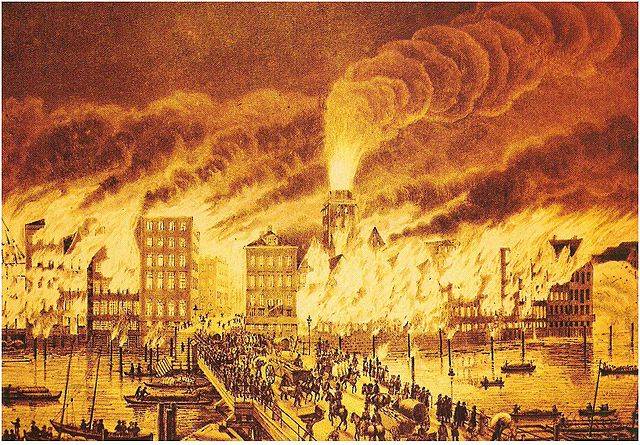
It lasted three days. Then he will be called Great. About a third of the city was destroyed, including 1700 large residential buildings, many private houses, more than 100 warehouses, seven churches, sixty schools and a number of public buildings, including the Bank of Hamburg. Killed 51 people, including 22 firefighters. More than 20 thousand people were left homeless. 70 thousand (almost half of the population) left the city.
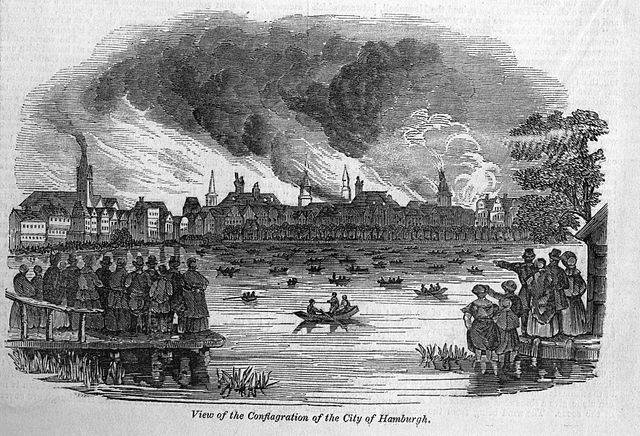
In this fire, Joseph Samuel Ballin, a successful cloth merchant who recently moved to Denmark from Hamburg, lost all his movable and immovable property.
There was nothing to do, and Ballin got a job as a clerk at the Morris & Co immigration agency. Thirteen children needed something to feed. Today Germany is a rich country, accepts thousands of emigrants, and in those days it, provincial and fragmented into principalities, lost about 100 people annually. Economic reasons pushed courageous and active people to leave for America to seek their fortune overseas. Many famous Americans have German roots. Among them are Levy Straus, and Henry Steinway, and William Boeing ...

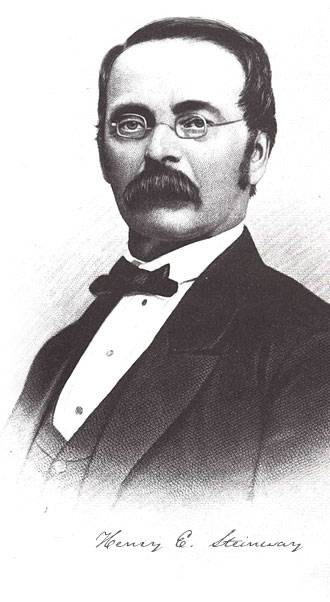

The agency supplied its customers with a full range of services: preparation and execution of documents necessary for emigration, tickets for a ship going to America, etc.
From those who wished there was no end, the agency flourished and expanded. Soon, Joseph Ballin became a partner there, and then a co-owner, having worked at the agency for almost 30 years.
In those days, passengers were transported across the ocean by cargo ships. The main profit was given to ship companies by cargo, and passengers served as a kind of “weight”. Nobody was particularly interested in the comfort and well-being of passengers, and people tried to fill the holds more tightly. In the holds and in the tweendeck, plank multi-story bunks were built for them, and this was considered the norm. There were still few ships. A “fast” crossing from east to west of the Atlantic on a sailing boat took about 40 days. The return flight with favorable westerly winds required "only" 28 days. Such a journey did not bring pleasure, they recalled it without much enthusiasm.
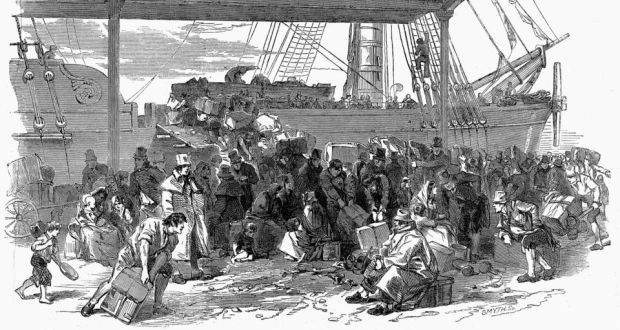
For example, Diamond sailed for 100 days to New York. Out of 180 passengers, 17 died from exhaustion. Many people died on sailboats and from epidemics, especially from cholera.
Newspaper Herald Tribune, October 26, 1853:
Although captains simply record the number of deaths in their reports, it is clear that the cause of these deaths is cholera, a fatal disease that causes such damage to shipping in Europe. It’s possible that some passengers died from common illnesses, but there is no doubt that cholera raged on board many ships, and this is confirmed by the fact that out of the quarantined immigrants, 33 were ill with cholera. ”
This is not surprising, in a tweendeck with a length of about 45 m and a height of only 1,8 m, up to 500 people huddled throughout the voyage - dirty, exhausted from stuffiness, pitching, and bad food. We slept in bunks located in three tiers (this is at a height of 1,8 m tweendeck!). For every emigrant, there was no more than one and a half meters of living space.
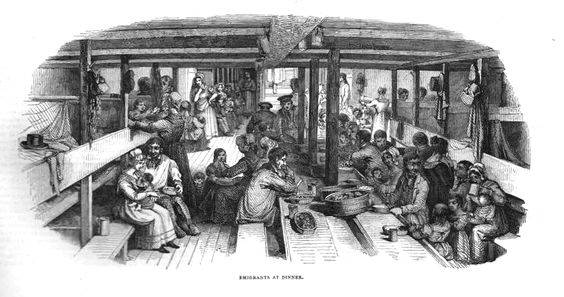
Light hardly penetrated through the hatch in the upper deck, through this hatch came fresh air. But in stormy weather, the hatch was lifted up, and cries, supplications and curses were muffled in different languages from the stuffy dark tweendek. No wonder the émigré vessels were called floating hell and floating coffins.
In 1874, Joseph Ballin passed away, and his youngest son, Albert, took a place in the agency. He was only 17. However, at 22 he had already become the head of the company. The flow of those wishing to leave the ocean, which had increased by that time, brought him a decent income. Having constant contacts with British and American businessmen, the young man improved not only his English, but also the skills of a businessman, manager and manager.
Ballin ordered the re-equipment of two cargo ships specifically for the transport of emigrants. This made it possible to improve swimming conditions and reduce the cost of tickets. The first ship with eighty immigrants on board left Hamburg on a flight to New York on June 7, 1881. Coal-powered steamers reduced travel time between Hamburg and New York to seven days. In 1883, there were already five such ships, and in a year they transported about 16 passengers across the Atlantic. In order not to drive the ships empty, commercial cargoes were delivered by return flights.
Having cooperated with another small company, Ballin began to reduce the price of a ticket to cross the North Atlantic and thereby put pressure on large shipping companies. Those, in turn, also reduced prices, losing a lot of money. Emigrants won first of all from such competition. In the end, the largest German shipping company Hamburg-Amerikanische Packetfahrt-Actien-Gesellschaft (HAPAG) admitted defeat in 1866. The rebellion of the shareholders led to a major restructuring at HAPAG, as a result of which Ballin was invited to lead her passenger division. Two years later, Ballin became a member of the HAPAG board of directors. He was only 31 years old.
In the same 1888, an even younger man began to rule Germany - Emperor Wilhelm II.
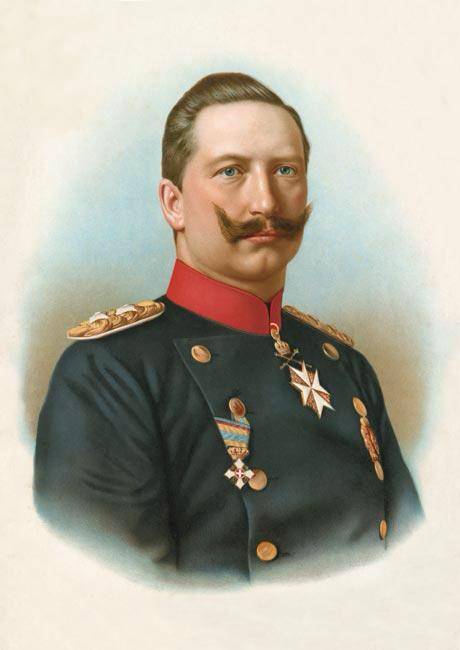
Kaiser attached great importance to the development of German fleet, not only naval, but also commercial. Naturally, HAPAG and, of course, its main “engine” Albert Ballin came into his field of vision. The emperor was not a philosemite, but this did not stop him from appreciating Ballin's talents as a brilliant administrator. He has repeatedly visited Hamburg, where Albert Ballin built a palace-villa specially to accommodate a distinguished guest. The emperor often met with the shipowner to discuss the political and financial aspects of the German maritime industry. Kaiser was such a frequent visitor at the Ballina Villa in Hamburg that she was called "Klein Potsdam" ("Little Potsdam").
Having enjoyed staying in luxury hotels in Paris, London and elsewhere, Ballin sought to recreate a similar atmosphere on HAPAG ships. Although there was still room for inexpensive passengers on its luxury liners, the upper decks were designed to compete with the luxurious homes and hotels that more aristocratic, wealthy passengers are used to.
Ballin was also a pioneer in the technical field. HAPAG is the first German company to commission twin-screw vessels. This gave her ships not only more speed, but also greater stability and security.
In 1890, Ballin first proposed the idea of cruise flights. They openly laughed at him and said that he was crazy.
At that time, a man boarded a steamboat or a sailing ship because of the cruel need to get, say, from Europe to America. It was Ballin who made sea cruises an independent business line, the main purpose of which was not to move the sea from one country to another, but to rest aboard a ship in warm latitudes.
In fact, this notion arose as a solution to an important logistical problem. The North Atlantic in winter is an uncomfortable place: cold, rain, storms, huge waves. Therefore, the number of passengers who wanted to reach America in the winter months was sharply reduced. In order for ships and crews not to stand idle, they should find a new job.
Ballin was the first to realize that there are a large number of rich people who are willing to pay for new entertainment, and gave them this entertainment. Cruise ships were not only equipped with powerful cars and the best navigation devices. They also impressed passengers with the luxury of decoration and many pleasant things, without which the harsh sailors, of course, could do.
In October 1887, HAPAG signed a contract with Vulcan AG for the construction of a passenger liner, the first German ship in its class. The ship was laid under slipway number 183 and was initially called "Normannia". However, even on the slipway, the name was changed to “Augusta Victoria”, in honor of the wife of Kaiser Wilhelm II, not noticing that an error crept into the spelling of the name. (correct spelling - August Victoria).
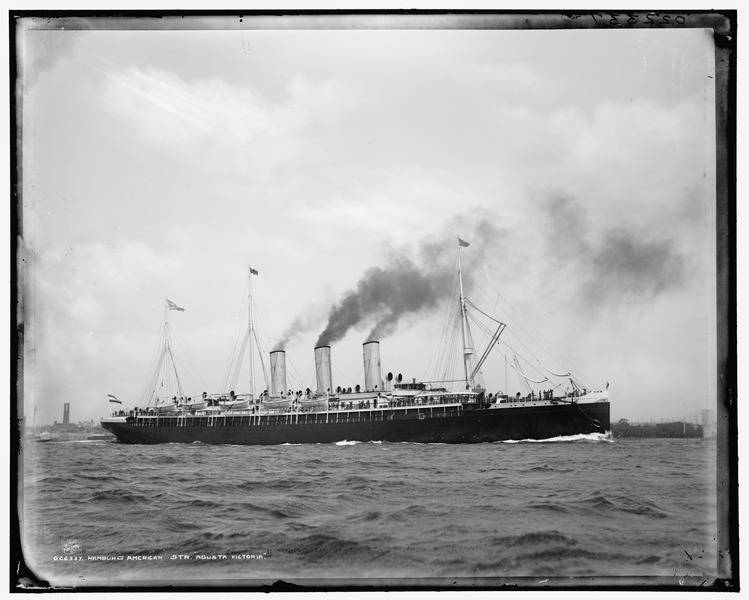
Displacement - 14 tons.
Length - 164,19 m.
Width - 17,17 m.
Height - 8,48 m.
Engines - 2 VTR, 9 boilers.
Power - 13 500 HP
Speed - 18,31 knots
Cruising range - 14 thousand miles.
On December 1, 1888, the liner was launched, on April 24, 1889, it was handed over to the customer, and from May 10 to 18 he made his first transatlantic flight along the Hamburg - Southampton - New York route.
The first cruise in the world Augusta Victoria set sail from Germany on January 22, 1891. On board the luxury steamer were 241 passengers, including the owner himself, Albert Ballin, and his wife Marianne. This cruise lasted 57 days, 11 hours and three minutes. Ballin's guests liked first-class cabins. There was also an excellent kitchen and a daily newspaper printed on board.
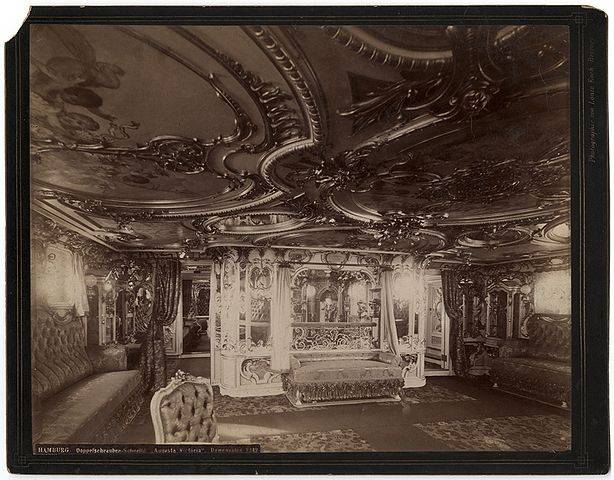
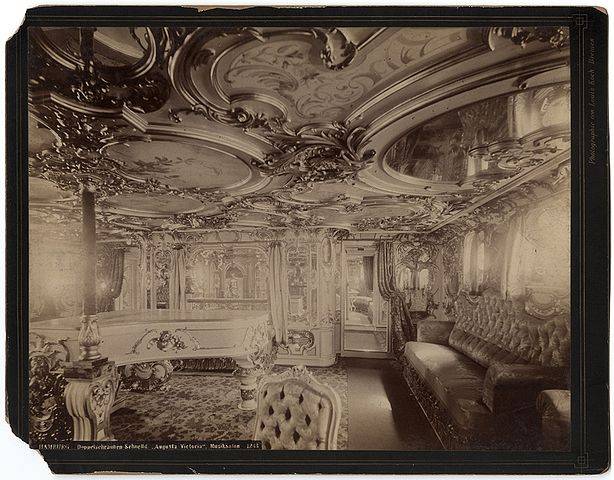
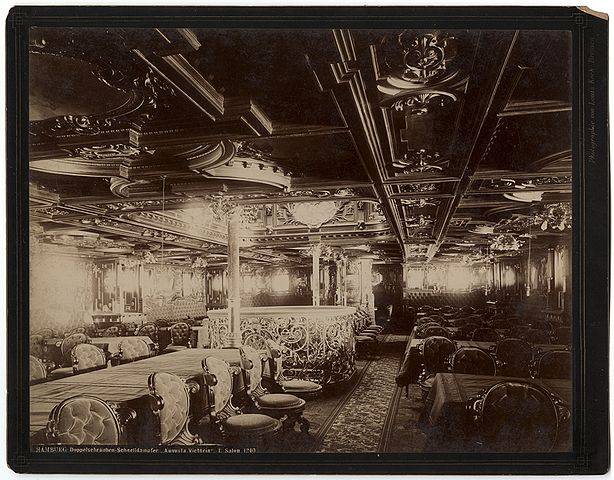
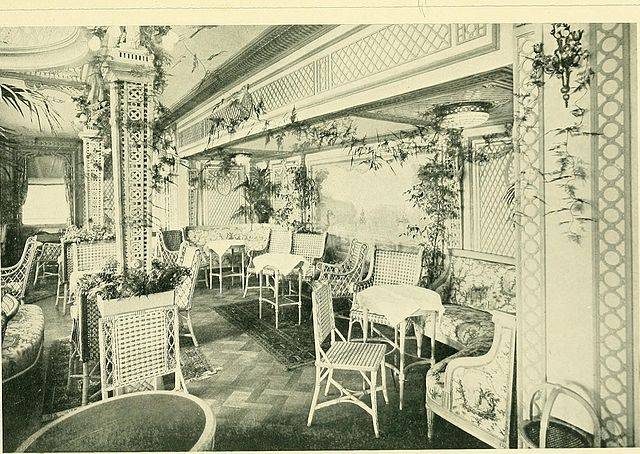
The ship stopped at more than a dozen ports (complete with coastal excursions), starting from Southampton on the south coast of Great Britain, through the Strait of Gibraltar, Mediterranean ports of call, including Genoa, Alexandria, Jaffa, Beirut, Constantinople (now Istanbul), Athens, Malta, Naples and Lisbon. When Augusta Victoria returned home after a two-month voyage, the cruise was rated as highly successful. Since then, every year (with the exception of periods of war), HAPAG has offered similar cruises. Such sea cruises to exotic places are now considered the norm, but in 1891 it was an innovative idea.
In 1899, Ballin became the CEO of HAPAG. Largely thanks to his efforts, Hamburg Amerika has become the world's largest shipping company. At its disposal were 58 of their own ships and 113 chartered.
Before the Russo-Japanese War, when Germany was a formally neutral side, HAPAG sold 16 ships to Russia and supplied the Russian Baltic Fleet with coal from Wales. Great Britain was an ally of Japan.
In April 1904, the Russian government acquired the Augusta Victoria airliner in order to use it for cruising services in ocean communications. On May 4 in Libau, he was received by the commission of Port Alexander III. The flag of the Voluntary Fleet was raised on the ship. On May 10, the Highest Decision was signed on the inclusion of the vessel in the lists of the Russian Imperial Fleet from the day it was admitted to the treasury.
After the repair, installation of weapons and re-equipment by the decision of the Admiralty Council on May 28, the liner from May 15 was enlisted in the Voluntary Fleet under the name "Kuban" as a ship of the 2nd rank.
The cruiser was assigned to the 6th naval crew, his captain was assigned the 2nd rank captain Khomutov.
The cruiser was included in the Second Squadron of the Pacific Ocean. May 21, 1905 was allocated from the squadron for cruising off the coast of Japan on trade communications to Yokohama from Vancouver, San Francisco and Honolulu in order to divert part of the forces of the Japanese fleet. Since May 26, he cruised at a distance of 90-130 miles from Tokyo Bay, having inspected during this time two ships (the German Surabaya and the Austrian Landroma), on which no smuggling was detected. On June 5, having stopped the operation due to a lack of coal, he went to Camran for replenishment. Upon arrival, he received information about the death of the 2nd squadron in the battle of Tsushima, after which he moved to Saigon and, having accepted coal, went to Russia.
Withdrew from the fleet on November 18, 1906 and sent to Stettin for analysis of scrap metal ...
The first years of the second decade of the twentieth century were going on, the production of armadillos was already rapidly growing in Germany. Cozy and nicely arranged Bell Epoque (Beautiful era), without slowing down, raced to its end, to the First World War.
Albert Ballin almost completely controlled the transportation of emigrants from Europe to America through the pool headed by him, which at different times included all passenger companies of the European continent, including the Cunard Line and the Russian East Asian Shipping Company. All pool companies in some years transported more than 3 million people.
Ballin was one of the few industrialists who considered it necessary to suspend this disastrous race. Being familiar with both the Kaiser and the British parliamentarians and members of the government, he tried to prove to both sides the absolute futility of the impending war. But they did not hear him and did not listen. Wilhelm II, learning about Ballin's anti-war position, forever lost interest in him ...
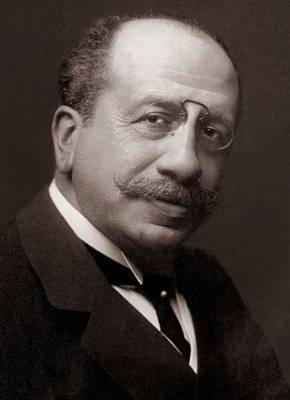
Albert Ballin took the news of the beginning of the war as a message about the beginning of the disaster. More than half of the company's vessels were sailing and were confiscated by the British and French in foreign ports. British ships blocked the sea lanes ...
As a result of a long war, Germany was ruined and was on the verge of a revolution. Seeing that he could not continue the work of his life as a commander who lost the main battle, Ballin made a fatal decision - he took a lethal dose of sleeping pills on November 9, 1918, on the day of the abdication of German Emperor William II. He died with an empire, the prosperity and power of which served all his life ...
However, HAPAG remained afloat after the defeat of Germany. And even benefited from this defeat. Under the terms of the Treaty of Versailles, the country was forbidden to build warships, but no one imposed a ban on the construction of passenger liners. In 1922, the first of a series of four ships, called the "Albert Ballin," was launched.
On this ship there was virtually no third class as it is depicted, for example, in the movie Titanic. Passengers enjoyed most of the amenities almost equally. The ship had a huge restaurant and wide passenger decks - at least play football, and a cinema, and a concert hall with a piano.
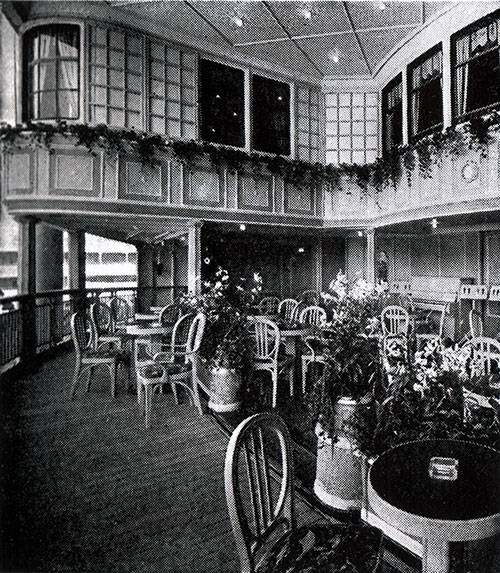
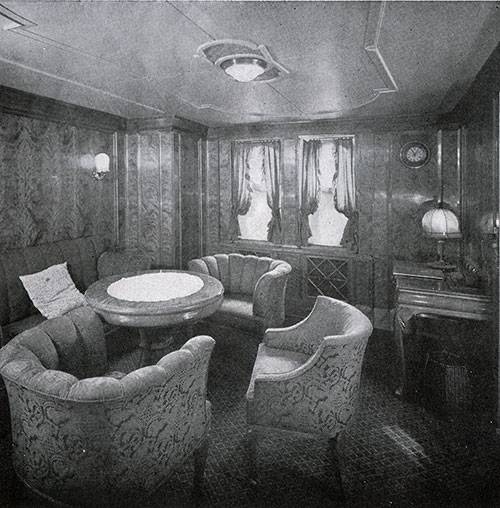
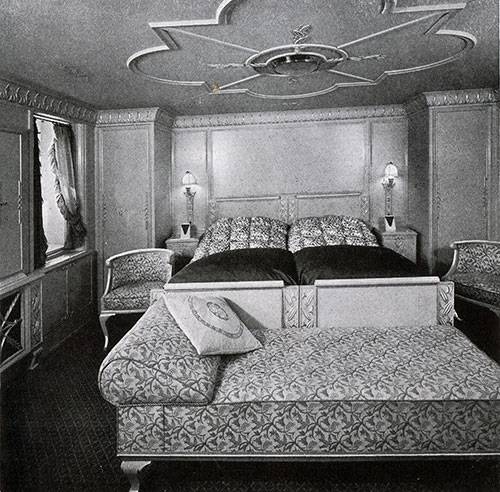
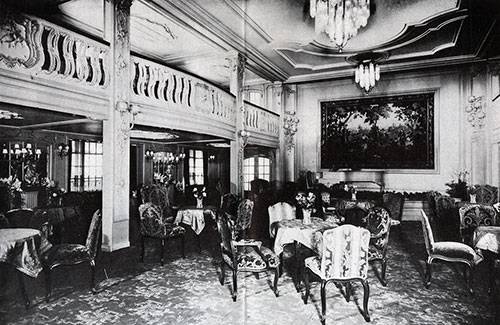
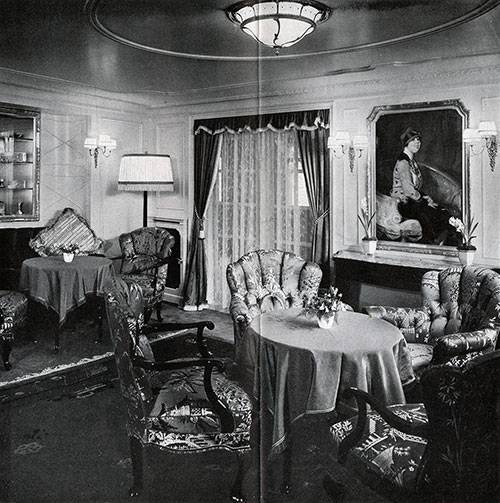
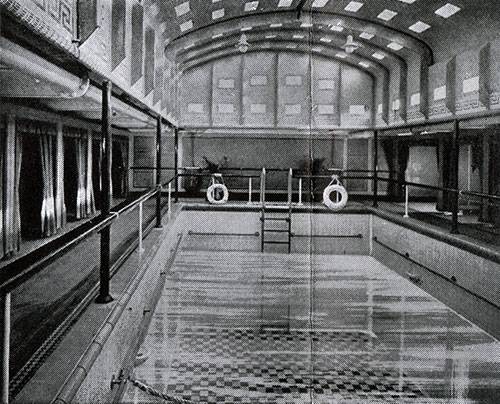
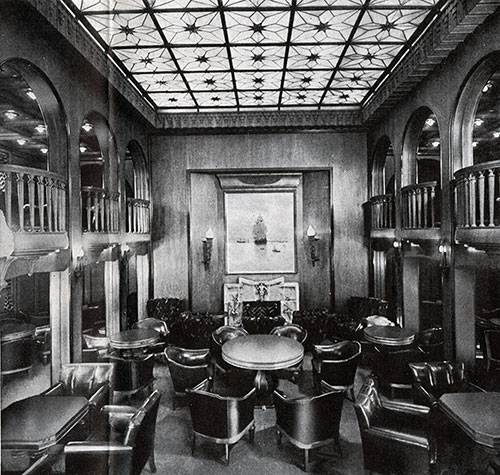
Albert Ballin was one of the first turbo-boats in the world. The lead screws were rotated by a powerful steam turbine. Therefore, the ship developed a speed of up to 18 knots and covered the distance from Europe to America in 10 days. Among other technical innovations of the vessel was a passive sedation control pitching. For this reason, passengers of German ships were less bothered by seasickness.
The passenger liner had a gross register capacity of 20 tons, a length of 815 meters, a width of 191,2 meters. Two steam turbines developed a total shaft power of 24 liters. with. The liner could take 13500 passengers in the 250st class, 1 passengers in the 340nd class and 2 passengers in the 960rd class. Fuel oil was used fuel oil.
External features of the vessel were four masts with cargo arrows and a distinctive outline of the bow. In its advertising booklet, HAPAG paid special attention to passengers at the following moment: “In addition to a variety of novelties designed to make the trip aboard a new vessel richer and more diverse, films will be shown to passengers of all three classes throughout the voyage. It will be especially pleasant on rainy and cold evenings, when passengers cannot stay on deck. ” In 1932, sound feature films began to be shown on board the ship.
The ship remained at the level of technological progress, since almost every year updating repairs were carried out on it. The power of the turbines increased, the radio communication improved, and the comfort increased.
After that, at the Blohm & Voss shipyard, by order of the HAPAG company, the following were launched: Deutschland (1924), Hamburg (1926) and New York (1927).
The ships were equipped with steam turbines operating on two propellers and for the first time in the history of German passenger shipbuilding had a cruising stern shape. The series was considered more "modest" than the pre-war series of the same company "Imperial Class". All vessels of the series were equipped with passive rolling dampers (Fram tanks), which gave them significant stability during excitement.
Like every ship, Albert Ballin had its own tragic pages.
On May 12, 1934, while mooring in Bremerhaven, the liner hit the accompanying tugboat Merkur and crushed it under itself. As a result, the tugboat drowned along with the entire crew (7 people).
With the advent of the NSDAP in 1933, a new page in German history began. In the Third Reich, the name of Albert Ballin, who, although he was a great German patriot until his “fingertips,” provoked sharp irritation in power. After all, Ballin, who once glorified the name and image of Germany, did not shine with Aryan origin. The HAPAG leadership was forced to submit to pressure from Berlin, and on October 1, 1935, the ship received a new name - “Hansa”.
The outbreak of World War II was not a surprise to German shipping companies. They stopped flights in advance, recalled vessels from foreign ports, gave captains secret instructions in case of emergency. On its last peaceful flight to New York, the Hansa set off on July 27, 1939 and, returning back, the airliner completed transatlantic flights. A month later, the war began.
During the war, the Hansa was used as a floating base near the port of Gotenhafen (Gdynia), where the cruise ship Wilhelm Gustlov was in the same role.
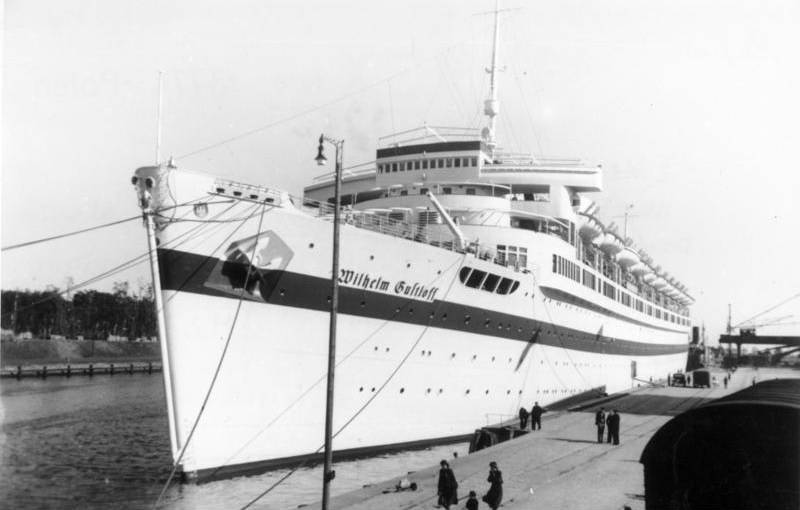
In late 1944 - early 1945, as the Red Army advanced, the German Navy began evacuating people and resources from East Prussia and Pomerania. For this purpose all possible vessels were used.
At the end of January 1945, the Hansa was supposed to participate in a convoy for the transport of German troops along with the liner Wilhelm Gustloff, which began to take refugees on board on January 22. At first, people were placed on special passes - primarily several dozen submarine officers, several hundred women from the naval auxiliary division and almost a thousand wounded soldiers. Later, when tens of thousands of people gathered in the port and the situation became complicated, they started letting everyone in, giving women and children an advantage. Since the projected number of seats was only 1500, refugees began to be placed on decks, in passages. Female military personnel were even placed in an empty pool. At the last stages of the evacuation, the panic intensified so much that some women in the port in despair began to give their children to those who managed to board, hoping to at least save them in this way. Towards the end, on January 30, the ship’s crew officers had already stopped counting refugees, the number of which exceeded 10.
Four hours after leaving Danzig on the "Hansa" there was a breakdown of the main car. The convoy stopped to reload and distribute troops to other vessels. The captain of the ship "Wilhelm Gustloff" decided to go further on their own without security ships ...
The commander of the Soviet submarine S-13, A. I. Marinesko, saw Wilhelm Gustloff, brightly lit against all standards of military practice, and for two hours followed him in the water position, choosing a position for attack. As a rule, the submarines of that time, even in the surface position, were unable to catch up with the fast liners, but the liner went slower than the design speed, being significantly crowded with passengers.
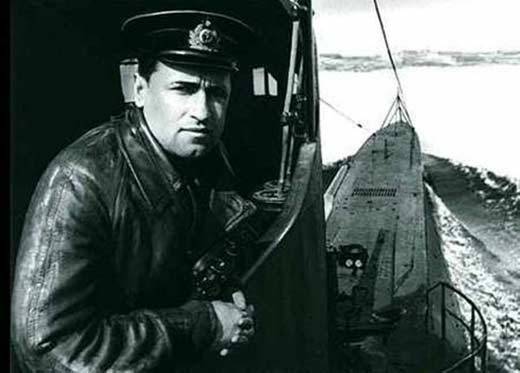
About nine o'clock, the S-13 entered from the shore and from the surface, from a distance of less than 1000 m at 21:04 launched the first torpedo with the inscription "For the Motherland", and then two more - "For the Soviet people" and "For Leningrad". The fourth, already cocked “For Stalin” torpedo, got stuck in the torpedo tubes and almost exploded, but they managed to neutralize it, close the hatches of the vehicles and sink.
At 21:16, the first torpedo hit the bow of the vessel, later the second blew up an empty pool where the women of the naval auxiliary battalion were stationed, and the last hit the engine room, the engines died out, but the lighting continued to work due to the emergency diesel generator. Those passengers who did not die from three explosions and did not drown in the cabins of the lower decks rushed to the lifeboats in panic. At that moment, it turned out that, having ordered the watertight bulkheads in the lower decks to be closed, according to the instructions, the captain blocked part of the team that was supposed to launch the boats and evacuate passengers. In a panic and stampede, not only many children and women died, but also many of those who climbed to the upper deck. They could not lower lifeboats because they did not know how to do this, moreover, many davits were icy, and the ship had already received a strong roll. By the joint efforts of the crew and passengers, some boats were lowered into the water, yet many people appeared in ice water. From a strong roll of the ship, an anti-aircraft gun fell off the deck and crushed one of the boats, already full of people. About an hour after the attack, Wilhelm Gustloff completely sank.
According to the results of the campaign, Alexander Ivanovich Marinesko was presented with the title of Hero of the Soviet Union, but the higher command refused this, replacing him with the award of the Order of the Red Banner. The motive for refusal was a number of disciplinary violations committed by him. At the end of 1945, for the same reasons, he was first demoted to the minesweeper commander, and then dismissed from the Navy. He worked in civilian positions. He died in 1963.
In late Soviet historiography, this event was called "Attacks of the Century."
On May 5, 1990, by decree of the President of the USSR Gorbachev M.S. Marinesko Alexander Ivanovich was posthumously awarded the title Hero of the Soviet Union.
In March 1945, it was the turn of the Hansa. On March 6, 1945, at full load near Warnemunde, on relatively quiet and shallow waters, the liner blew up a mine and lost speed. The attempt to tow the ship to the shore was unsuccessful, and the ship sank. However, all passengers and the crew managed to escape due to the fact that the Hansa sank for a long time and sat on the ground, not completely hiding under the water. The sea depth at this place was 20 meters, and the ship gradually lay on the port side, so that the starboard side protruded above the water to a height of about 5 meters. In this form, the liner lay on the ground for more than four years ...
The fate of the Hansa was shared by the rest of the quartet.
"Hamburg" on March 7, 1945 was blown up by two English aviation mines and sank off the island of Rügen, near the German city of Sassnitz. "Deutschland" was sunk by British aircraft on May 3, 1945 in the German port of Lubeck. The New York was killed on April 3, 1945 in the port of Kiel.
In accordance with the decisions of the Potsdam Conference of the leaders of the three Allied Powers (USSR, USA and Great Britain), the German naval and merchant fleets were divided between the victorious countries due to reparations. After the division of the German fleet by the tripartite commission, the Hansa and Hamburg, of the same type, were moved to the USSR. Other liners of this series, “Deutschland” and “New York”, went to the British. The British picked them up, towed them to England, but found restoration impractical and butchered it for scrap.
In 1947, the Baltic Fleet emergency rescue service examined the sunken Hansa, after which a decision was made to lift it. The difficulty of lifting consisted in the fact that the vessel was heavily silted, and the shallow depth made it difficult to set it on an even keel. The work lasted about two years, and only on December 15, 1949 the ship was picked up and taken to Warnemunde, where the Warnow Werft shipyard was reconstructed. Reconstruction of the engine room, superstructure and restoration of the premises continued for another four years.
Since the vessel was immediately intended to operate on the Vladivostok - Petropavlovsk-Kamchatsky coastal line with a traditionally large passenger flow, the restoration project provided for almost the same passenger capacity as was originally built. At the same time, 4 cargo holds and luggage compartments were saved, and the upper deck became continuous. The tonnage of the vessel grew to 23.009 tons.
The ship was equipped with 10 cabins “lux” and 2 cabins “special suite” for only 20 passengers, 90 cabins of the 1st class (150 passengers), 85 cabins of the 2nd class (404 passengers) and 85 cabins of the 3rd class (602 passengers ) In addition, the ship could take 2.280 tons of general cargo. Of the four masts on the liner, only two were left: one in front and behind the superstructure.
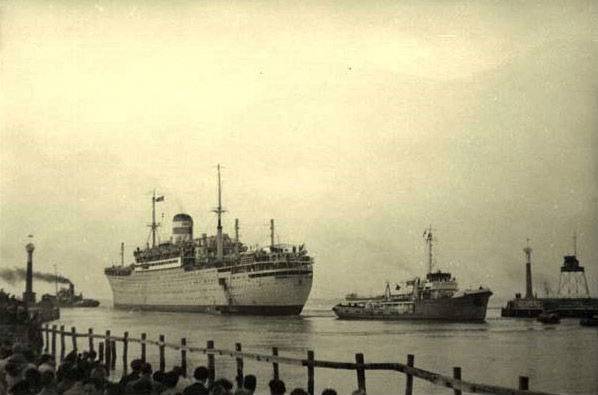
During the reconstruction, two chimneys were replaced with one fashionable then “dome-shaped” shape. A similar configuration of the pipe was also used on English liners of the Saxonia type (later Leonid Sobinov), which were being built at the same time. During the repair, due to the lack of highly qualified specialists, it was not possible to completely restore the turbines and to center the main gearboxes. For this reason, the power of the main machine was recommended to be reduced to 14.000 liters. sec., which provided a speed of 16,5 knots.
Since this ship was the largest passenger ship in the USSR, there was no doubt about what to name the new ship: “The Soviet Union”.
The official assignment of the new name took place in 1953. In total, the recovery lasted five years. However, shortly before the planned date of putting into operation on the ship for unknown reasons, an explosion and fire occurred, severely damaging the premises of the liner. Repeated restoration followed, and in September 1955 the ship was handed over to the customer.
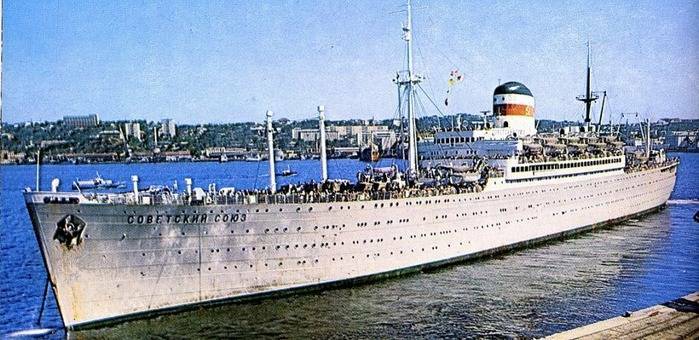
In 1955, the Far Eastern branch of Sovtorgflot "Soviet Union" was put into operation.
The Hamburg was raised in 1950, undergoing refurbishment in Warnemünde and Antwerp. The vessel was named "Yuri Dolgoruky", and an acceptance team from Vladivostok was already sent to Germany. But in 1957, at the level of the USSR government, it was decided to convert the ship into a whaling base based in Kaliningrad.
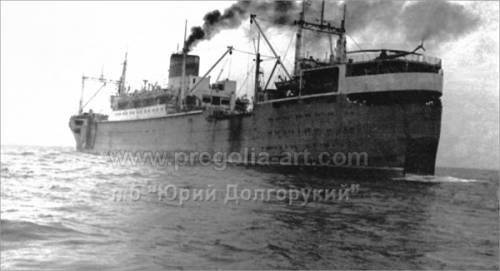
Since 1960, the Yuri Dolgoruky floating base has been actively used in the whale fishery in many parts of the World Ocean: mainly off the coast of the Antarctic, in the southern Indian Ocean off Kerguelen Island and in the South Atlantic. In connection with the international convention, which sharply limited the fishing of whales, the floating base “Yuri Dolgoruky” was decommissioned in 1977 and cut into scrap metal.
"Soviet Union" was put on an express coastal line: Vladivostok - Petropavlovsk-Kamchatsky. After the defeat of Japan, South Sakhalin and the Kuril Islands again returned to the USSR. It was necessary to transport people with their property, food, industrial equipment and other goods. Normal life began to be restored in all other regions of the Far East. A large flow of goods and passengers was also sent there, mainly going to the fishing industry for organizing. The ship worked on this line almost until the end of its existence.
The Sovetskiy Soyuz savership completed work on the Kamchatka passenger line on November 30, 1980 and, in accordance with the order of the head of the Far Eastern Shipping Company No. 1037 of December 2, 1980, was joked for dismantling equipment, removing materials, technical supplies and preparing the vessel for delivery scrap metal.
By order of the Minister of the Navy of the USSR No. 256 dated December 5, 1980, the Soviet Union liner was decommissioned from the balance of the transport fleet, after which it was renamed “Tobolsk” by order of the head of the FESCO; it is clear that with the name "Soviet Union" it simply could not be subject to butchering.
On March 5, 1982, “Tobolsk” independently entered the last voyage for cutting with a crew of 60 people under the command of Captain Gennady Alexandrovich Kobtsev, and on March 17 of the same year the vessel was officially handed over for cutting to metal by one of the Hong Kong companies ...
PS In 1974, during the visa-free cruise to the equator without calling at foreign ports, the Soviet citizen Stanislav Kurilov fled from the Philippines off the coast of the Philippines. With fins, mask and snorkel, without food or drink, for 3 days he sailed to the island of Siargao about 100 km. But this is a completely different story ...
Sources:
Albert Ballin. Der Reeder des Kaisers.
Mark Blau. Who invented sea cruises?
Four lives of the “Soviet Union” // LJ “Periscope”.
Ocean Travel Vintage Brochures GG Archives.
Wikipedia articles and others
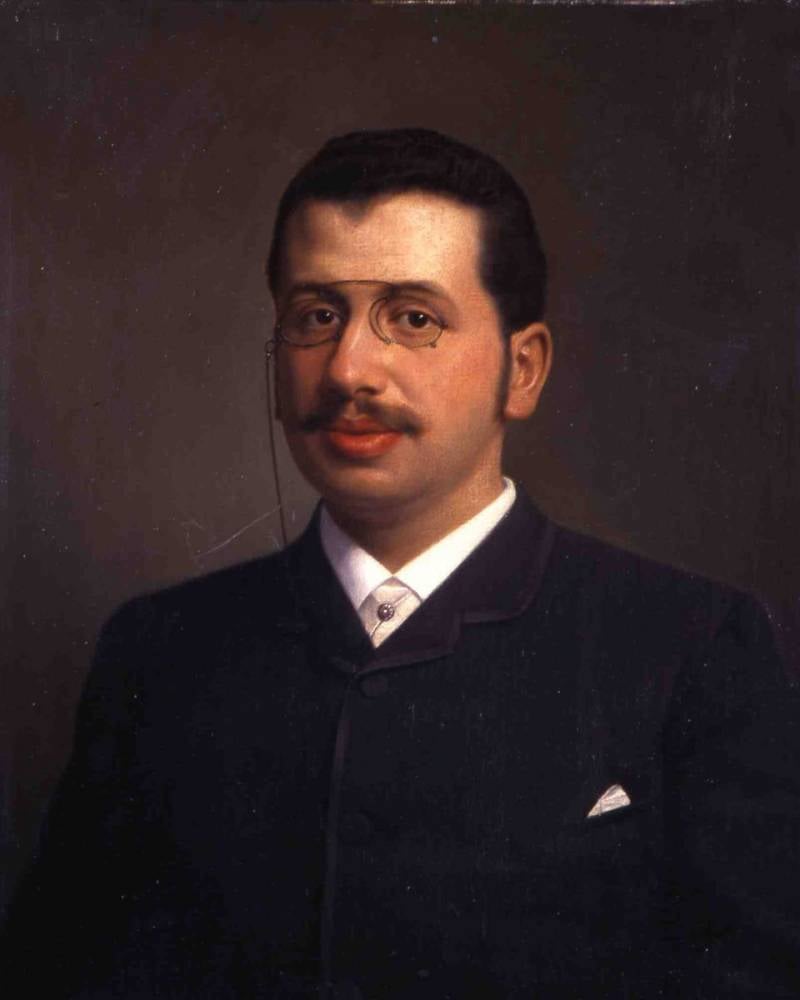
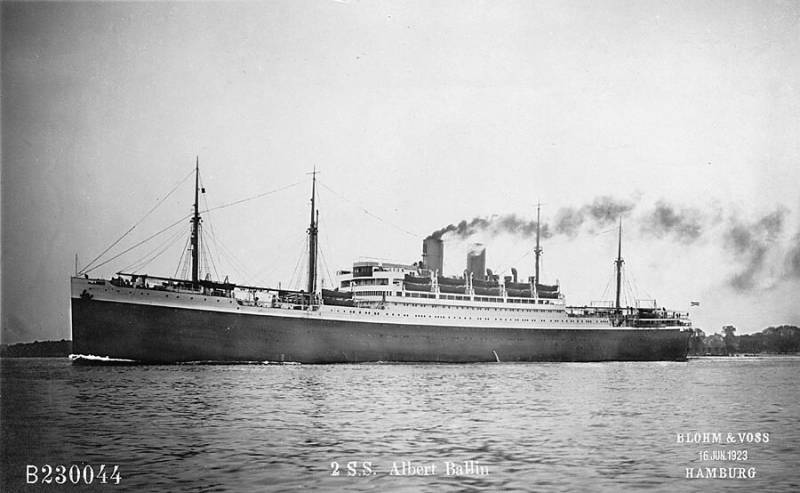
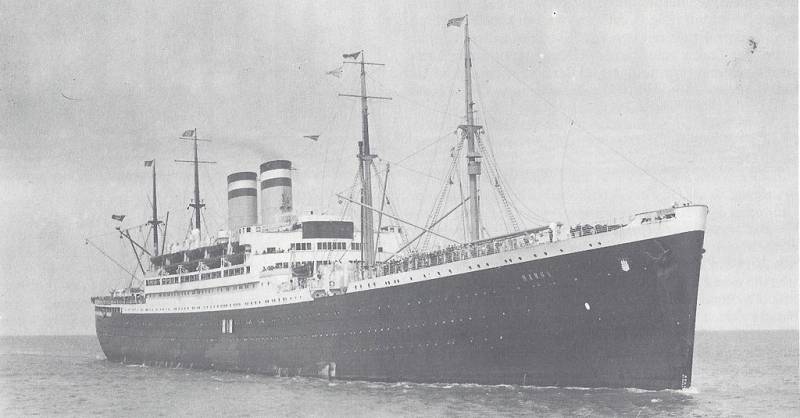
Information